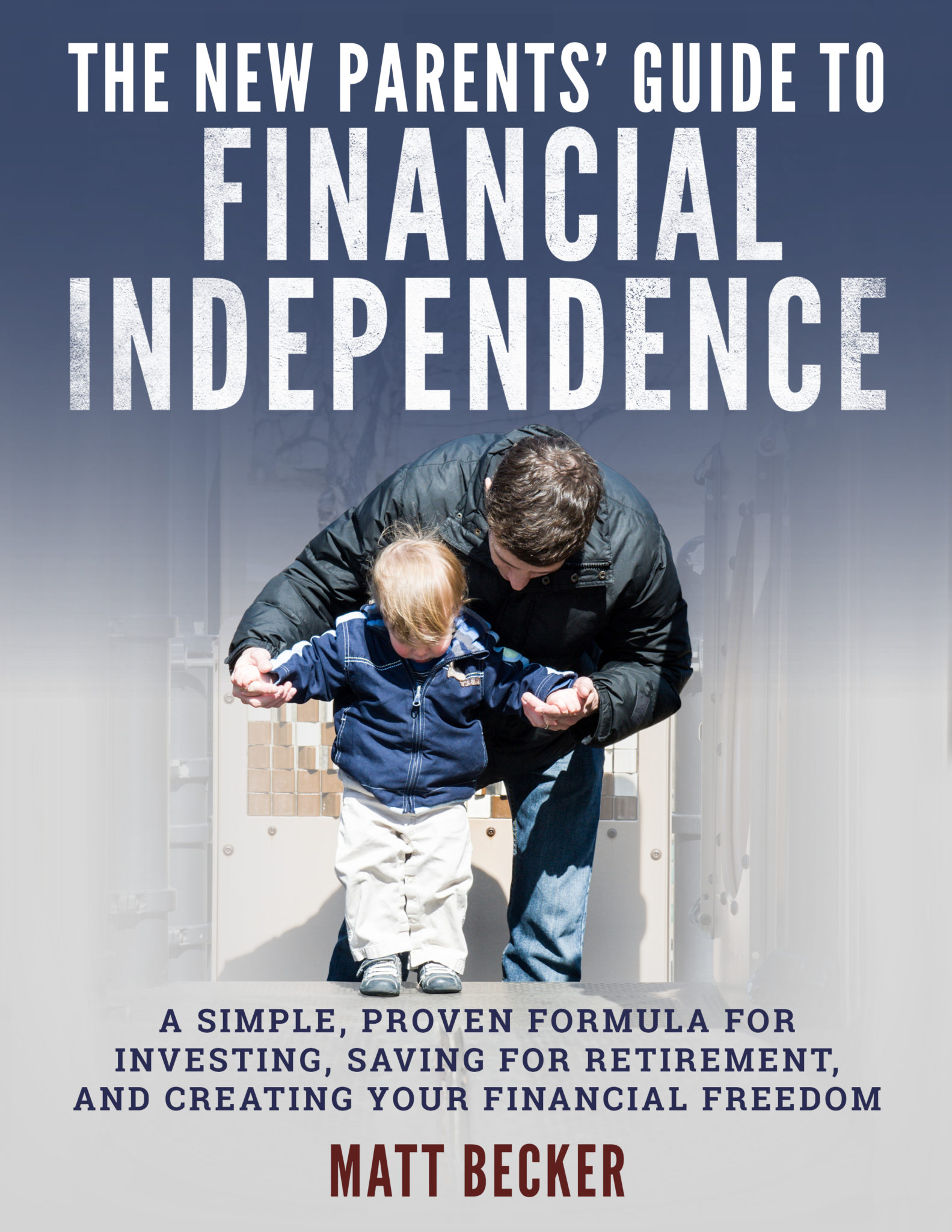I was fortunate enough to receive an advance copy of Matt Becker’s new book, The New Parent’s Guide to Financial Independence. Matt wrote the book as a way to teach new parents how to retire early, but the book’s message is relevant to us all.
Overview of the book
 The book starts out how it should, it runs you through a couple of activities to help you think about what truly matters in your life in order to focus your efforts, and your saving and spending, on those goals.
The book starts out how it should, it runs you through a couple of activities to help you think about what truly matters in your life in order to focus your efforts, and your saving and spending, on those goals.
You are encouraged to involve your spouse and have them do the activity on their own, then compare so you can prioritize together. My wife, Anna, and I haven’t done the activities together yet, but I hope to do so on our vacation for my 40th birthday later this month.
Financial Independence
Matt asks you to shift your thinking towards financial independence and away from the traditional goal of retiring at age 65. Financial independence is defined by Matt as “the freedom to make decisions based on what makes you happy instead of what makes you money.”
The activity that starts you and your spouse down the road towards financial independence consists of 8 easy steps, including #8, which is to regularly re-evaluate your goals.
Savings Rate
When assembling your investment strategy, Matt argues that your savings’ rate is the most critical component. I agree that is the case when you are first starting out, but once you have been saving for 5-10 years, I believe that your investment returns matter much more than the amount you continue to save and invest.
It is still important, in my opinion, to invest throughout your life. However, the impact of increasing your annual investment returns by 0.1% matters significantly more than saving one more dollar, or even $100 more, once your balances reach $100,000 or more.
The key is to start saving now… an imperfect investment strategy started today is far more valuable than the “perfect” plan started 10 years from now.
Matt offers a Financial Independence Savings Calculator spreadsheet that helps you determine how much you should be saving to reach your financial independence goal. It factors in you and your spouse’s age, current savings, retirement age, retirement expenses, ad expected Social Security income to arrive at your monthly savings target.
My monthly savings target for Financial Independence
I turned 40 this month, and I would like to retire by the age of 55… at age 50, if things go the way I hope they do.
Using the basic assumptions of the Financial Independence Savings Calculator spreadsheet, I need to save $5,750 a month to be able to generate $10,000 a month in retirement. The problem is that the calculator’s default assumption is an investment return of 6.2%. Considering that I’m heavily invested in stocks, with very little invested in bonds, this investment return assumption is far lower than what I should reasonably expect.
I changed the investment return to be 8%, and my monthly savings required shrank to $3,816. At 9%, it is $2,757. I’m saving about $1,800 a month in my retirement accounts between my contributions, matching, and profit sharing. Additionally, I’m saving in taxable accounts through Betterment, Acorns, and various other investment opportunities.
When factoring in the investment income I will receive from my rental real estate investments, the amount needed to save each month will drop even more. Unfortunately, the Financial Independence Savings Calculator spreadsheet does not allow you to factor in additional income streams. In future improvements, this would be a great addition!
What if I can’t save that much?
The reality is that most people haven’t saved enough so far in their lives, and they cannot afford today to save the “ideal” amount each month to catch up.
Matt and I agree that you need to start saving today, no matter how small the amount may be. Then, continue to look at how you’re spending your money each day, week, and month to determine if what you’re spending money on is worth more to you than the goals of financial independence / retirement are in the future. Whether it is cutting out sodas or coffee when dining out or eliminating cable TV, there are some ways to save. And, you can boost your savings one-time by selling unused items around the house or getting a 2nd or better job by learning a new skill to increase your income.
Basically, if you don’t think you can save $100 a month today, what makes you think you can save $500 a month in a couple of years?
Where to save the money for your financial independence?
This is where I don’t agree with Matt’s ideas in the book as it relates to my life. The book is focused on financial independence, which I translate into “early” retirement – in your 40s or early 50s.
Matt’s suggestions are focused entirely too much on the traditional retirement accounts that we all know about – 401(k) up to employer’s match, maxing out your IRA, and then continuing to invest in your 401(k) until you max it out. These are great investment vehicles, and should be part of everyone’s investment strategy, but they are meant to be withdrawn after age 59 1/2. If you’re retiring early to gain your financial independence, then accessing these accounts will incur a 10% penalty. Besides, since we’re factoring in Social Security as part of our traditional retirement age income streams, so the focus needs to be how to fund financial independence BEFORE traditional retirement age.
You can use the Roth variations of the 401(k) and IRA to provide the option of withdrawing contributions prior to 59 1/2, but I favor taking the tax deduction today – a bird in hand is worth two in the bush.
I did like his suggestion to fund a Health Savings Account and taxable investment accounts, but I also feel that other investment options, that will provide income in your 30s, 40s, and 50s should have been discussed.
Aside from contributions to my retirement accounts, I favor investing in rental real estate for the monthly income stream and tax benefits that it provides. In fact, because I started funding my retirement accounts in my 20s and plan to retire in my early 50s, I have scaled back my retirement contributions only to the level in which I max out the company match (for my company, that means I contribute 6% and they match 50%, for a total of 9% plus any profit sharing that is awarded). The rest of my savings go into taxable investments and rental real estate properties.
Another financial independence hurdle
As I talk with friends and family today, and when I used to work in financial planning, something that would interfere with people planning for their retirement / financial independence is the goal of saving for a child’s education.
Yes, this is important. But, children can get scholarships for grades, athletics, and community service… or they can take out loans or hold a part-time job on or off campus. Plain and simple, they have options.
For retirement, there really is only one option… you must save. There is no such thing as a retirement scholarship.
And, speaking from personal experience, the best gift a parent can give their child is the knowledge that their parents are taken care of in retirement so the child can focus on themselves, their career, and building their own family.
Since this book is focused on new parents, I would have liked to read Matt’s opinion of this emotional topic.
In summary
Although I disagreed with a few of Matt’s premises, it is a great book that is a quick read. My financial situation and goals are probably different than many new parents since we had our two children in my late 30s. Regardless of your financial situation, you can revisit this book time and again with your spouse to ensure the goals you set before are still relevant. And the Savings Calculator is a useful tool to help you determine your ideal savings rate. Even though the title mentions new parents, I would recommend this book to anyone who needs help clarifying their goals and the steps to reach them.





Great review! I appreciate what you said about saving for kids. Never thought of it that way but there is so much truth in that. I took out loans and have been fine paying them back. My parents are financially independent and will even have money to leave behind thanks to the efforts of my dad. It is such a relief to me that I won’t have to try and figure out how to take care of them and my kids! I appreciate what you had to say and see that our retirement accounts are more important to fund at this time. Thanks!
Thanks Anjuli. I’m a big proponent of saving for your child’s education, but not at the expense of saving for your own retirement. An easy way to save for your kid’s education without sacrificing your retirement efforts is to sign up your credit cards for the UPromise program. You’ll receive cash back at participating stores and gas stations, without affecting the price you pay or costing you anything to sign up! If you want to supersize these rewards, UPromise offers a credit card as well. If you want to sign up, shoot me a message, and I’ll share a link with you.